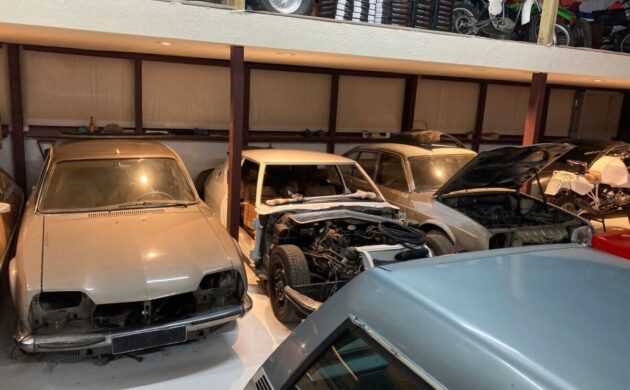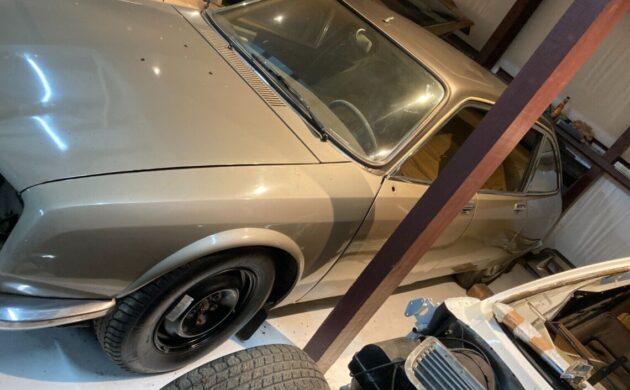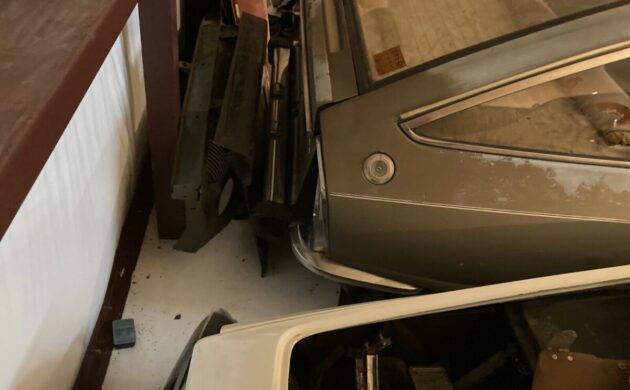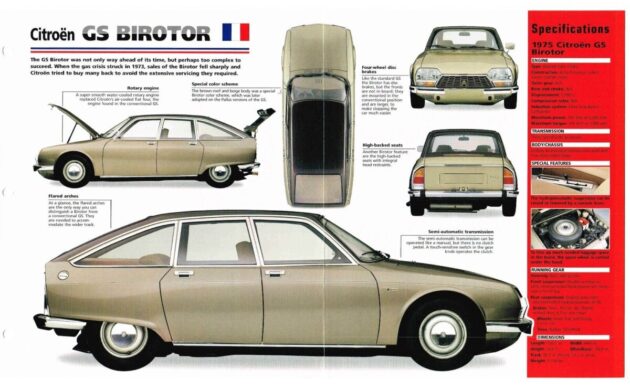Whenever the topic of discussion turns toward production cars powered by the legendary Wankel rotary engine, two manufacturers spring to mind. The most obvious is Mazda, which utilized the powerplant in its “Rx” series vehicles. The other shining light is NSU, with the rotary finding its way under the hood of its brilliant, innovative, but fatally-flawed Ro80. Less recognized is Citroën’s contribution, which is understandable considering so few of its GS Birotors rolled off the line. When the Birotor proved a dismal failure, the company attempted to buy back and destroy the entire production run. They failed, and a few survive today. The seller doesn’t have one of these classics for sale, but the winning bidder could walk away with a pair. They need work, but the rarity could make it worth the effort. The Citroëns are listed here on eBay in Willis, Texas. Bidding sits below the reserve at $3,200, although there is a BIN option of $7,500. I must say a big thank you to Barn Finder Kyle K for spotting this rare pair.
Citroën launched its GS model in 1970, offering it as a fastback saloon and an estate wagon. The styling was quite conservative by the company’s standards, with the model marching along with only minor cosmetic changes until 1979. The shape owed much to advanced aerodynamics, allowing the GS to provide excellent open-road performance from engines with modest power outputs. The Birotor utilized a slightly revised GS body, with small wheel arch extensions to accommodate its wider front track. The seller doesn’t mention rust issues with either vehicle but says that the winning bidder will probably cannibalize one to return the other to a complete state. Rust doesn’t tend to be an issue with these cars in dry climates, meaning it might only take basic panel preparation and painting to return the Citroën to a presentable state. It appears the glass and trim are present, and once the restoration project is complete, the extra car could serve as a long-term source of spare parts.
Unfortunately, the seller provides no engine photos. This is a shame because what resides under the hood made these classics rare. Citroën entered a partnership with NSU under the umbrella of Comotor SA. The two companies pooled resources to bring Wankel rotary-powered models to the market. NSU produced the fatally flawed Ro80, while Citroën unveiled the Birotor in 1974. As the name suggests, the powerplant in the GS featured twin rotors, bringing a significant power increase to the table. While those handing over the cash for the similarly-equipped GS 1220 had 66hp from its four-cylinder motor to cover the ¼-mile in 20.9 seconds, the Wankel churned out 107hp, slashing the ET to 18.6 seconds. It was a similar story when attention turned to top speed. The GS 1220 could hit 92mph, but the Birotor climbed to 109mph. Of course, it wasn’t all good news because the engineering changes required to house the powerplant and semi-automatic transmission added 530 lbs to the base GS curb weight. However, that wasn’t the biggest issue. As with other motors of this breed, the Birotor’s engine was prone to apex seal failure and other reliability problems. The company’s timing was appalling, launching the car at the height of the energy crisis. With this model consuming fuel more than 30% faster than its four-cylinder stablemate, many potential buyers struggled to justify the additional cost…but the price was probably the killer punch. The regular GS model that closest aligned with the Birotor on equipment was the 1220, but buyers paid a 67% premium over the 1220’s sticker price for the silky smooth Wankel. Naturally, there weren’t many takers, and after tearing up a small fortune with the venture, Citroën pulled the pin in 1975. The listing indicates there is only one motor between this pair of classics, and its condition is unclear. In researching this article, I chanced upon a German company called Rotech that specializes in rebuilding these motors. I could not locate a website, but information suggests the Rotatif Birotor Club in France may be willing to point the new owner in the right direction. If the winning bidder has no luck locating a domestic company to undertake the work, this could be a viable alternative.
The seller supplies only limited interior photos, making it difficult to draw any conclusions about the condition of either car. It may be possible to use pieces from both cars to assemble one complete and tidy interior, and this could be easier than you might think for a rare classic of this caliber. All Birotors rolled off the line with high-back front bucket seats, which are just visible in some photos. It is worth noting that every car also featured identical Hazelnut interior trim with “Moquette” upholstery. Therefore, interchanging pieces between cars should not present a challenge. The photos suggest the interiors may be complete, giving the buyer something to work with.
The 1974 Citroën GS Birotor was a failed experiment, suffering the bad timing that has claimed other promising models. The company produced 847 examples, but a high sticker price and heavy fuel consumption saw buyers stay away in droves. The company attempted to buy the entire production run back from the owners so they wouldn’t face stockpiling expensive spares for such a rare vehicle. They managed to get most of them, but it is believed that somewhere between 150 and 180 cars slipped through the net. Someone has the chance to own a pair, although the sad reality is that one will probably serve as a parts car to restore the other. Naturally, these cars rarely come to market. When they do, prices above $35,000 are typical. If these beauties are rust-free, returning one to our roads could be worth the cost and effort. Are you up for the challenge?












Good write up, never knew this manufacturer even built a rotary powered car. If they weren’t quirky enough they went over the line to this level. I’ve stated earlier, who bought these cars new and what was the attraction? Had to be more than their single spike steering wheel.
So many car manufacturers were caught up in the Wankel. NSU as mentioned and GM which was banking on a small efficient power plant to power their small car line-up. AMC was caught up in the hype designing their Pacer around the little engine. In the end all they ended up with was a little engine that had filthy emissions and burned more fuel than a conventional piston engine. The GS and the CX were the last true Citroëns before Peugeot bought them in 74 after the Wankel bleed them dry. I would shelf the bi-rotor engine and make an adapter plate to install a Mazda Wankel.
Ironically Mazda reverted back to the days of poor reliability with the Renisis engine in the RX-8 leaving a bad taste in owner’s mouths.
Yeah GM and AMC wanted in the rotary phenomena, even Benz tried but of them all only Mazda got it to work reliably. Couple motorcycles tried the engine. Suzuki being the most successful. Yes they are dirty but got to say get them set up and tuned they can make serious power very quickly.
https://nihilistnotes.blogspot.com/search?q=Wankel
Some sources say the GZ was more responsible than the SM for the financial implosion Citroën suffered in 1974 but the demise of both cars marked the end of the company’s most interesting era. Still, at 847, GZ production was actually more prolific than the only Wankel-engined car ever sold with a body made by General Motors: the Mazda Roadpacer.
ABC… thank you for the article. Sounds like Hanns Dieter Paschke should receive more recognition. As an engineer, we have a term. “Anyone can have a brain-fart, but only a select few can turn them into something useful.” While Felix Wankel was given credit, he may not have really been the first to even have the “brain-fart”. Whereas Hanns Dieter Paschke figured out how to turn those brain-farts into the fundamentals of the rotary engine that endured for four decades and may be coming back as a range extender. From now on I might just refer to it as an “epitrochoid engine”.
An ungainly beast but certainly rare.
Thought I read in a Brit mag only 800 or so were sold, might be worth it to buy and peddle it to a French collector. Myself, nothing French ever appealed to me, other than Alpines.
A couple comments. Great write up, I didn’t know about the attempt to buy them back. Also curious about displacement, as there is conflicting information from under 1000cc up to 2000cc. As fun as it would be to put a Mazda engine in it… These really need to remain original due to the limited number of them still in existence.